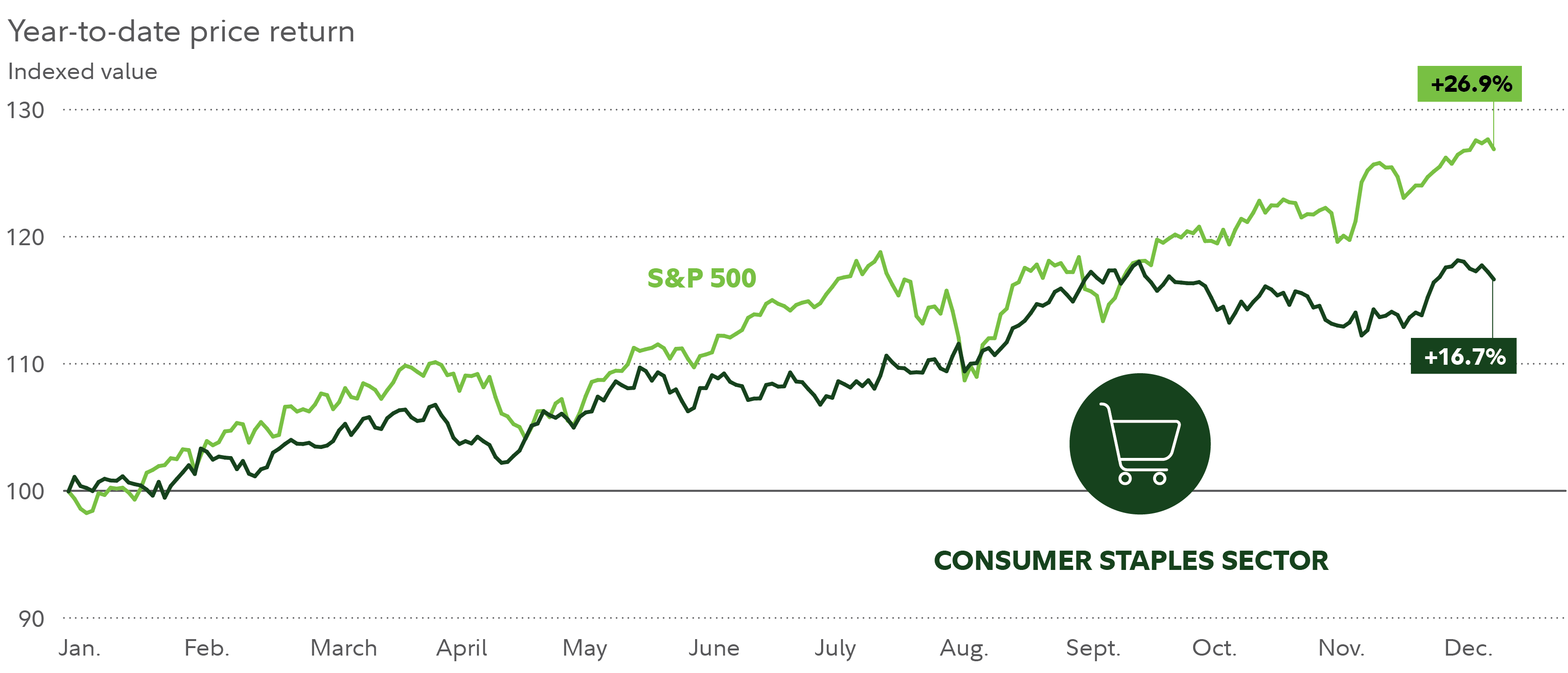The consumer staples sector has had a positive year in 2024—albeit with returns that lagged the market as investors favored higher-growth stocks.
With sector dynamics now returning to normal, I am expecting a positive outlook for the sector in general in 2025. I am particularly excited about the potential value that stock picking could add in the year ahead, given the sector's rich landscape with wide valuation spreads, which may present opportunities to identify turnaround stories or undervalued stocks.
2024: Shifting sentiments
The consumer staples sector encompasses makers of everyday items like packaged food, toothpaste, and dish detergent. It's considered to be a "defensive" sector because these items are necessities and consumers still tend to buy such products even when times are tight, and because the sector includes many mature dividend-paying companies.
But that positioning continued to be a drag, not a boost, on relative performance throughout most of 2024 after staples fell out of favor in 2023. That's because investors generally shunned defensive stocks in favor of a narrow segment of mega-cap growth companies (particularly those with ties to artificial intelligence). Still-high interest rates further hindered the performance of stocks in the sector that pay dividends, which are often viewed as alternatives to bond investments. Concern that GLP-1 weight-loss drugs may reduce consumption of certain foods and beverages also weighed on the sector.

While those factors weighed on relative performance, the sector still had a strong year in absolute terms—and had posted double-digit gains for the year as of mid-December.
2025: A return to normal
Looking ahead to 2025, I anticipate that the consumer staples sector could return to normal, against an economic backdrop that looks broadly stable, and with a somewhat stressed—but not severely strained—consumer environment. Overall, consumer demand is stable, consumer balance sheets remain strong, employment is healthy, and real wage growth is steady. With the Federal Reserve beginning to cut rates, I believe the sector's outlook is positive.
I believe this environment may allow consumer staples stocks to perform more favorably versus the broader market in the year ahead. Against that backdrop, my focus will continue to be on core fundamentals and traditional industry drivers, such as operating in favorable market structures and maintaining strong underlying growth profiles. I believe companies like Procter & Gamble (
One uncertainty that could impact the sector in the year ahead may be changes in trade policy that result from the incoming presidential administration. Key areas to watch include tariffs and the strength or weakness of the US dollar. Regarding tariffs, most consumer staples products are made in the US, so direct effects of tariffs might be limited. Products like alcohol from Mexico and items with Chinese components (e.g., packaging and small appliances sold by consumer staples retailers) could see price increases. On the bright side, I believe that after living through changing tariff policy in recent years, consumer staples businesses may be better prepared for tariffs now. Strengthening in the US dollar is another key issue I'm watching, as this could hurt staples businesses with international exposure.
Ultimately, the sector's performance in the year ahead may—as with other sectors—depend on the performance of the broader economy. Because it is such a defensive sector, consumer staples has historically tended to shine in times of economic weakness. Despite the market's current optimistic growth expectations for the broader economy in the year ahead, I remain more measured. If economic growth fails to meet the high expectations bar, defensive sectors like consumer staples could perform better.
Fund top holdings1
Top-10 holdings of the Fidelity® Select Consumer Staples Portfolio (
- 13.6% – Procter & Gamble Co. (
- 12.2% – Coca-Cola Co. (
- 9.61% – Keurig Dr Pepper Inc. (
- 7.09% – Walmart Inc. (
- 6.60% – Kenvue Inc. (
- 4.41% – Monster Beverage Corp. (
- 4.00% – Estee Lauder Cos Inc. Cl A (
- 3.91% – Energizer Hldgs Incl. (
- 3.87% – Target Corp. (
- 3.82% – Constellation Brands Inc. Cl A (
(See the most recent fund information.)
A focus on pricing power and continued demand
The sector has been offering a fertile environment for stock picking thanks to wide valuation spreads—meaning wide differences in measures like price-earnings (PE) ratios between the most expensive and least expensive stocks. This has created opportunities to invest in turnaround stories or undervalued stocks with strong company-specific theses.
Among those best positioned for 2025 may be the soft drinks and nonalcoholic beverages subsector. Energy drinks have seen long-standing growth as their acceptance has become more widespread. For example, Monster (
I've also been finding opportunity in spirits stocks within the distiller and vintner segment, as I believe these stocks are poised to benefit from consumer purchasing patterns returning to normal. During the 2020 COVID-related lockdowns, the spirits segment experienced significant growth as people, stuck at home, increased their consumption of alcohol and built personal inventories of favorite brands. Now that life has returned to normal, consumers have been buying fewer bottles since they have the option to enjoy drinks at bars and social gatherings, reducing the need to dip into and augment their own supplies. This sales slump was a factor in the decline of several top spirits stocks in the past year.
However, while consumers are buying less at retail, it doesn't appear that they are drinking materially less overall. Given this, in my view the stocks of alcohol-manufacturing businesses have recently been undervalued. In my opinion, companies like Diageo (
Potential opportunities in undervalued stocks
With a stable economic backdrop and a supportive Federal Reserve, I believe the consumer staples sector may be well-positioned for a return to normal fundamentals. My focus remains on core fundamentals and traditional industry drivers, with an aim of identifying favorable market structures and strong growth profiles. Additionally, wide valuation spreads may present numerous opportunities to invest in turnaround stories and undervalued stocks, making this an exciting time for the sector.

Ben Shuleva is a portfolio manager and research analyst in the Equity division at Fidelity Investments.
In this role, Mr. Shuleva manages Fidelity Select Consumer Staples Portfolio, Fidelity Advisor Consumer Staples Fund, Fidelity VIP Consumer Staples Portfolio, and the consumer staples subportfolio of Fidelity U.S. Equity Central Fund. Additionally, he is a research analyst responsible for researching food & non-alcoholic beverage, household product staples, and U.S. tobacco companies.
Prior to his current role, Mr. Shuleva was an equity research associate from 2008 to 2011 where he began his career researching stocks. He has been in the financial industry since joining Fidelity in 2008.
Mr. Shuleva earned his bachelor degree in finance from Southern Methodist University. He is also a CFA® charterholder.



